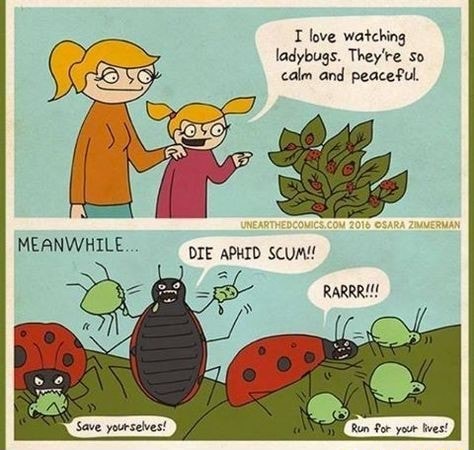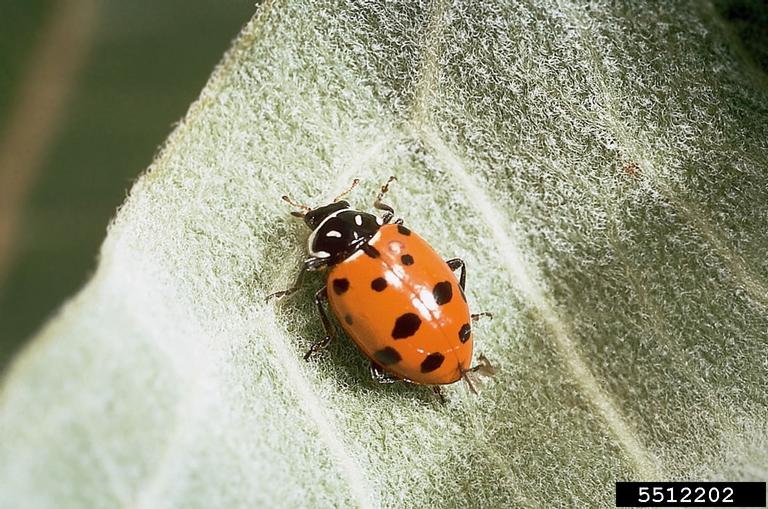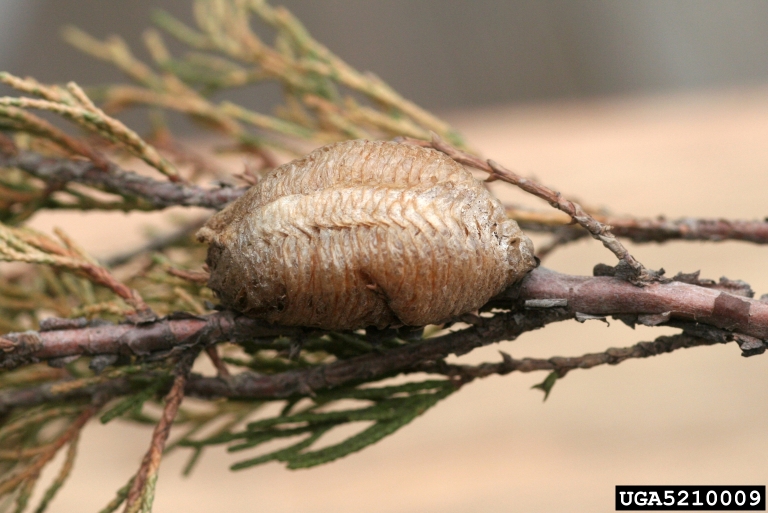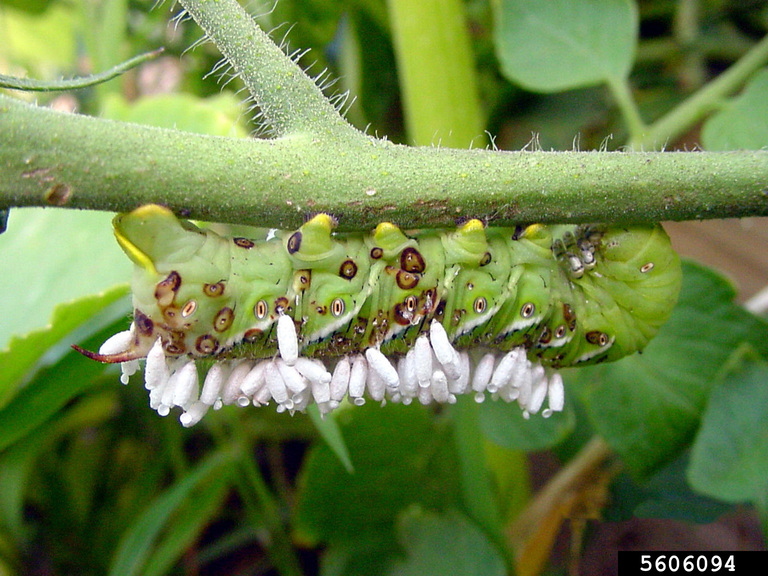Biological control is the use of natural enemies such as predators, parasites/parasitoids, and pathogens of pests in order to suppress or control them. This is a great tool for pest control and we hear about biological control a lot, especially when we talk about IPM (Integrated Pest Management). It usually comes with the classic imagery of a hungry lady beetle (often incorrectly referred to as the lady ”bug”) munching on aphids.

Yes, many lady beetle species are great predators of pest insects…so much so, that the multicolored Asian lady beetle (Harmonia axyridis) was intentionally imported and released in North America in 1916 as a more ‘natural’ way to control common pests. Species of North America’s native convergent lady beetle (Hippodamia convergens) were also collected from their habitat (around 1924) and relocated to agricultural locations within California for aphid control, which showed high success rates.
Another popular insect that comes to mind when we think about biological control is the mighty and charismatic praying mantid (aka praying mantis). These ferocious predators, in the family Mantidae, are beautiful and captivating creatures that even grab the attention of the non-entomologically-inclined. With their large eyes and raptorial front legs, you can’t help but be fascinated by them. Although there are some native species of mantids in North America, the ones you are most likely to come across in your yards and gardens include the European mantid (Mantis religiosa) and the Chinese mantid (Tenodera sinensis). Like their names suggest, these are not native to North America, though they have been here for over a century being both accidentally and intentionally introduced overtime. The Carolina mantis (Stagmomantis carolina) is another mantis that you might come across, especially in the southeastern United States, and this one is native to the Americas, from the southern US to Brazil.

(Photo: Whitney Cranshaw, Colorado State University, Bugwood.org )
The predatory nature and biocontrol successes of some of these insects have given rise to their popularity as a commercial pest control product and resulted in an increased interest in purchasing them. These are widely available online, in nurseries, garden centers, and in several other retail outlets. Often marketed as a “good alternative to pesticides” the intention behind this practice is a positive one: reducing unnecessary pesticide use by incorporating beneficial insects that will help manage pests in the landscape. That being said, like many other simple and catchy solutions to common issues, this may not be the most responsible or effective option for home gardeners to reduce pest populations while still being good stewards of their yard and garden ecosystems.
What are the issues associated with releasing purchased beneficial insects in home gardens?
Introducing populations of species into new ecosystems can have several unintended consequences. This applies to non-native and native species alike. A Washington State University Extension publication by our very own Dr. Linda Chalker Scott and Dr. Michael Bush from the Washington State Department of Agriculture does a great job of summarizing some of the issues. Whether or not they are native or widespread throughout the country and/or continent, not all regions and/or ecosystems may have high numbers of these insects and their introduction could result in competition with other common predatory arthropods and further unintended ecosystem impacts. These insects can also consume beneficial organisms, especially in the case of praying mantids, who are just as likely to feed on any insect they catch including other predators, pests infested by parasitoid wasps, and even pollinators. In some of these insects, cannibalism is also a common survival strategy, especially if resources are scarce.

(Photo: Kansas Department of Agriculture , Bugwood.org )
Introducing these insects into new locations can also introduce their pests, including potential parasites and diseases, which could impact previously unaffected populations and even other species of beneficial insects in our home landscapes. This doesn’t even account for the ethics of sourcing some of these insects and the impacts of removing large quantities from their natural habitat.
Does it actually work for controlling yard and garden pests?
One of the first things that happen when you release these purchased insects into your home gardens is that many will simply disperse. That is, if they survive the harsh conditions of sitting on a store shelf in hot temperatures. In fact, to have the most success in releasing them in your gardens, you need to take special care and pay attention to factors including time of day/temperature and the number and type of pest insects available for them to eat. For more detailed information on lady beetle release best practices, see this publication from UCANR.
Commercially available convergent lady beetles (H. convergens) are harvested as adults in a dormant state from their overwintering sites. They have a migratory behavior where they will disperse before they feed and lay eggs. As mentioned in this publication from Cornell University, some commercial insectaries will feed these adult beetles a special diet to reduce this migratory behavior. If you do still plan on purchasing lady beetles, these could be a better option. Even if these beetles don’t disperse once you have released them, you need enough pest insects to make it worthwhile for them to stick around for a little while. Although H. convergens are considered generalist predators that feed on aphids, scales, thrips, other soft-bodied insects, and even pollen and nectar when prey are scarce, their preferred diet is aphids. Unless you have heavy aphid infestations in small areas, it’s probably a waste of money (and lady beetles) to introduce them to your landscape. If you do however have a very heavy infestation of aphids, you need to make sure you have enough lady beetles to do the job properly. Even if you do everything correctly and have ample aphids for them to eat most lady beetles will still fly away after a couple of days. They are unlikely to lay eggs on the plants that they are released on thus requiring subsequent releases to continue managing a concentration of pests.

(Photo: Scott Bauer, USDA Agricultural Research Service, Bugwood.org )
Mantids, on the other hand, are released as egg cases (ootheca) or newly hatched nymphs from those egg cases. You will often see mantid egg cases available for sale, and if you don’t release them within a day or two of hatching, most of these nymphs will cannibalize each other. You can try to spread them out around your garden, but they will still likely eat any arthropod that they come across and catch (including other beneficial insects). They are also unlikely to stay localized around a specific pest issue, so they’re not really effective pest control agents. More information on mantis releases can be found in this publication from University of New Hampshire.

(Photo: Whitney Cranshaw, Colorado State University, Bugwood.org)
What is a better alternative to purchasing insects for home gardens?
Encouraging the natural enemies that are already in your yard and garden landscapes (also known as conservation biological control) is the best way to incorporate long-term and effective biocontrol for home gardens. These natural enemies include predatory beetles, lacewings, parasitoid wasps, spiders, and countless others!

(Photo: Gerald Holmes, Strawberry Center, Cal Poly San Luis Obispo, Bugwood.org )
Sustaining these beneficial critters also means providing a diversity of habitat, including food and shelter for them. Include a variety of flowering plants all season long because these natural enemies will also feed on nectar and pollen in addition to their prey. Let your landscapes be a little ‘wild’ by keeping some leaf litter, rotting wood, dead perennials, and ornamental grasses which provide shelter for overwintering. More information on encouraging insects for biocontrol in home landscapes can be found here.
Another important factor for maintaining beneficial insects in home gardens is to utilize IPM strategies when pest outbreaks do occur and to minimize unnecessary pesticide use, especially pesticides that are broad spectrum, or persist in the environment for long periods. Utilizing cultural controls, barriers, and tolerating a little bit of pest damage is all going to contribute to the long-term health of your home garden ecosystem.